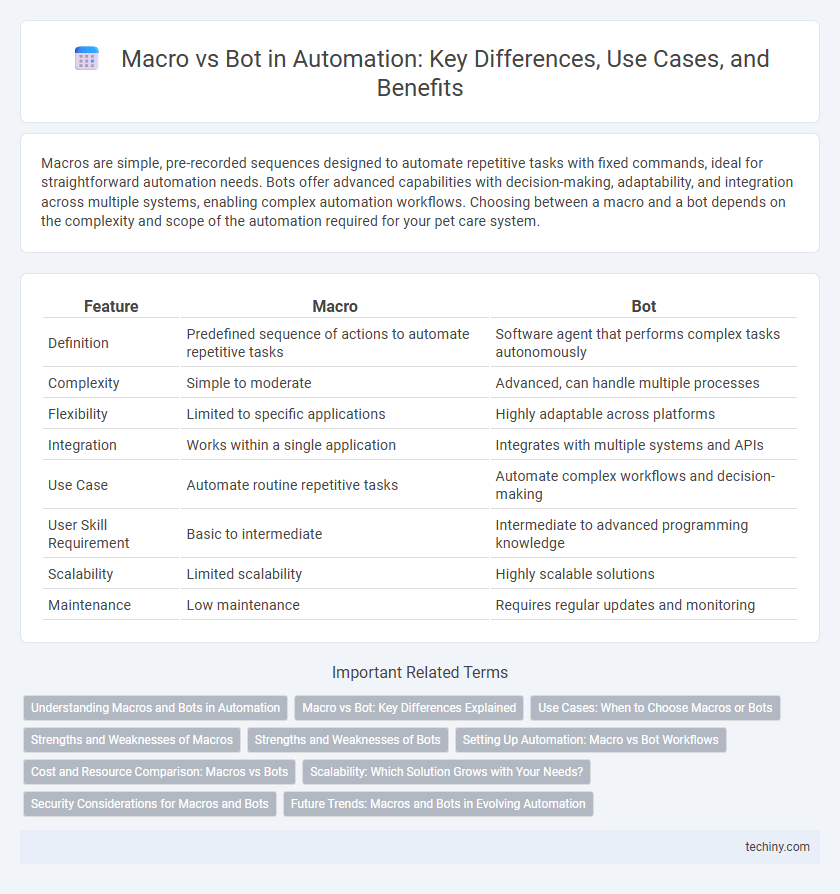Macros are simple, pre-recorded sequences designed to automate repetitive tasks with fixed commands, ideal for straightforward automation needs. Bots offer advanced capabilities with decision-making, adaptability, and integration across multiple systems, enabling complex automation workflows. Choosing between a macro and a bot depends on the complexity and scope of the automation required for your pet care system.
Table of Comparison
| Feature | Macro | Bot |
|---|---|---|
| Definition | Predefined sequence of actions to automate repetitive tasks | Software agent that performs complex tasks autonomously |
| Complexity | Simple to moderate | Advanced, can handle multiple processes |
| Flexibility | Limited to specific applications | Highly adaptable across platforms |
| Integration | Works within a single application | Integrates with multiple systems and APIs |
| Use Case | Automate routine repetitive tasks | Automate complex workflows and decision-making |
| User Skill Requirement | Basic to intermediate | Intermediate to advanced programming knowledge |
| Scalability | Limited scalability | Highly scalable solutions |
| Maintenance | Low maintenance | Requires regular updates and monitoring |
Understanding Macros and Bots in Automation
Macros automate repetitive tasks by recording user actions and replaying them within specific applications, making them ideal for simple, rule-based processes. Bots extend automation capabilities by utilizing AI and machine learning to handle complex workflows across multiple systems, enabling dynamic decision-making and adaptability. Understanding the distinct roles and technical foundations of macros and bots is essential for optimizing automation strategies in business environments.
Macro vs Bot: Key Differences Explained
Macros automate repetitive tasks by executing predefined sequences within specific software, making them ideal for simple, rule-based processes. Bots, powered by artificial intelligence and machine learning, perform complex tasks across multiple systems and can interpret unstructured data. Unlike macros that are limited to specific applications, bots offer enhanced adaptability, scalability, and integration capabilities for broader automation needs.
Use Cases: When to Choose Macros or Bots
Macros excel in automating repetitive, rule-based tasks within specific software applications, such as data entry in spreadsheets or batch processing in word processors. Bots are better suited for complex workflows involving multiple systems, like customer service chatbots handling queries or RPA bots automating end-to-end business processes across various platforms. Choose macros for straightforward, application-specific automation and bots for multi-step, cross-application tasks requiring decision-making capabilities.
Strengths and Weaknesses of Macros
Macros excel in automating repetitive tasks within specific software applications, offering simplicity and speed in execution without requiring complex programming skills. Their primary limitation lies in their inflexibility and dependence on static interfaces, making them susceptible to breaking when user interface elements change. Macros lack advanced decision-making capabilities and integration support compared to bots, which are designed for broader, intelligent process automation across multiple systems.
Strengths and Weaknesses of Bots
Bots excel in handling complex, repetitive tasks with high accuracy and scalability, especially in environments requiring real-time data processing and integration across multiple systems. Their ability to adapt through AI and machine learning enhances efficiency in dynamic workflows, though this sophistication demands higher initial development costs and ongoing maintenance. Limitations include potential security vulnerabilities and dependence on stable IT infrastructure, which can affect bot performance and reliability.
Setting Up Automation: Macro vs Bot Workflows
Macro setups involve recording and replaying a specific sequence of user actions to automate repetitive tasks within a single application, providing simple rule-based automation ideal for straightforward workflows. Bot workflows utilize advanced software robots capable of integrating multiple systems, executing complex logic, and handling exceptions, making them suitable for enterprise-level automation across various platforms. Choosing between macros and bots depends on the complexity of the task, integration requirements, and scalability needs within automation projects.
Cost and Resource Comparison: Macros vs Bots
Macros require minimal initial investment and are ideal for simple, repetitive tasks with low resource consumption, making them cost-effective for small-scale automation. Bots involve higher upfront costs due to complex development and infrastructure needs but offer scalable solutions for large-scale, dynamic processes with advanced accuracy. Choosing between macros and bots depends on the automation scope, budget constraints, and resource availability in the organization.
Scalability: Which Solution Grows with Your Needs?
Macros offer limited scalability, typically automating repetitive tasks within specific applications without adapting to changing workflows or increasing volumes. Bots, leveraging advanced AI and machine learning, scale efficiently across diverse systems and complex processes, handling higher transaction volumes and evolving business requirements. Enterprises prioritizing long-term growth benefit from bots' ability to integrate seamlessly and expand functionality as operational demands increase.
Security Considerations for Macros and Bots
Macros often pose security risks due to their ability to execute code within applications, potentially enabling malware or unauthorized access if malicious scripts are embedded. Bots, while more complex and capable of automating broader tasks, require stringent authentication and encryption protocols to prevent exploitation in network environments. Implementing role-based access control and continuous monitoring reduces vulnerabilities associated with both macros and bots in automation workflows.
Future Trends: Macros and Bots in Evolving Automation
Macros will continue to streamline repetitive tasks through simple script automation, while bots are evolving with AI integration to perform more complex, adaptive processes across various industries. Future trends highlight bots leveraging machine learning and natural language processing to enhance decision-making and user interaction. The convergence of macros and bots within intelligent automation platforms is expected to drive greater efficiency and scalability in business operations.
Macro vs Bot Infographic

 techiny.com
techiny.com